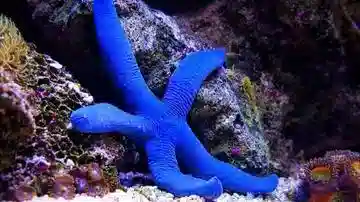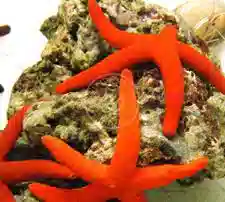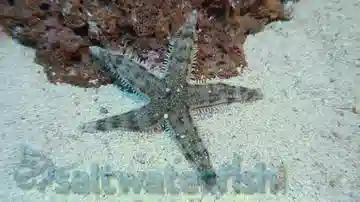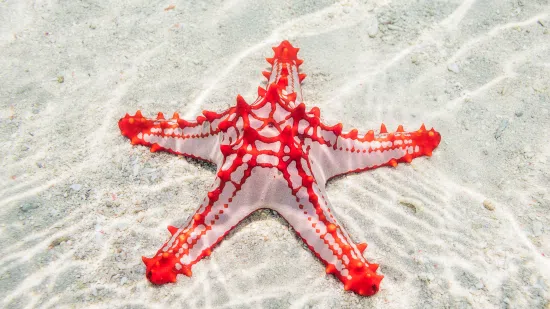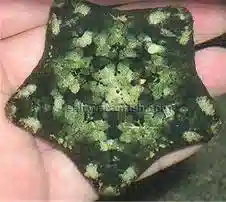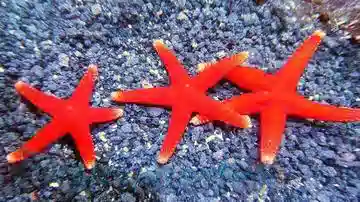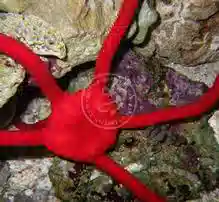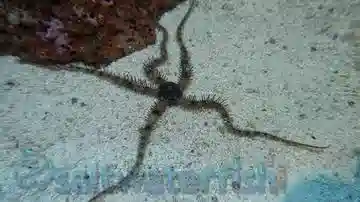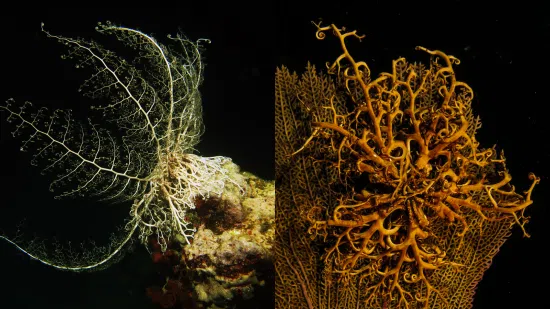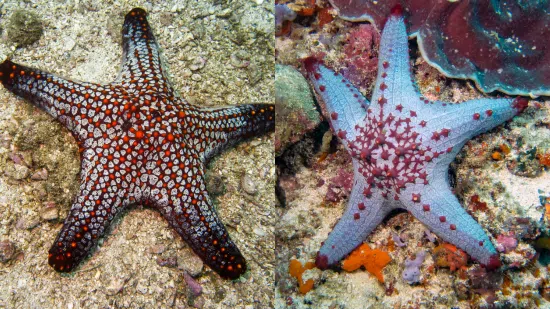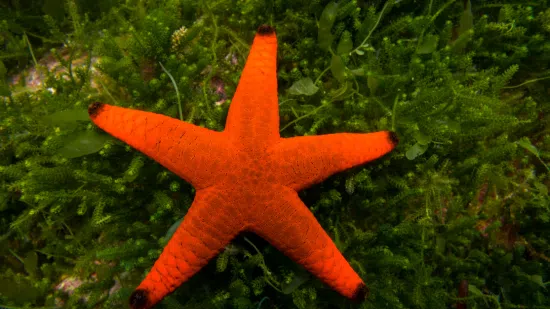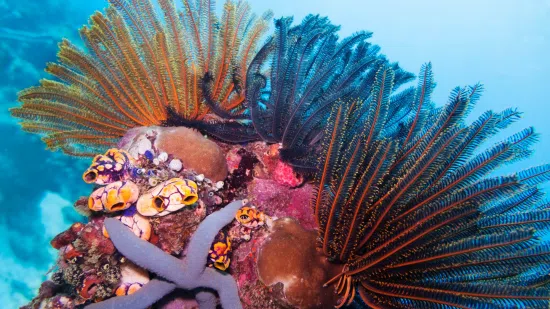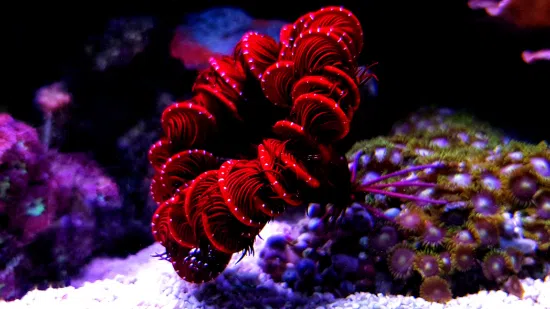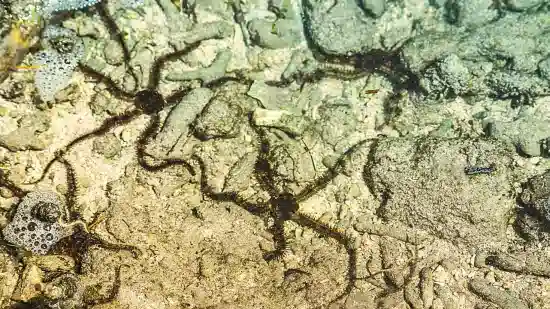Starfish In Saltwater Aquariums: FAQ
You can keep more than one starfish in a saltwater aquarium but only if your tank is large enough, well-established, and properly maintained. Starfish are delicate invertebrates that require stable water parameters, mature biological filtration, and ample natural food sources. When housed correctly, multiple species can coexist peacefully and even enhance the diversity and balance of your reef ecosystem.
Key factors to consider before adding multiple starfish
Tank size and maturity: Aim for at least 75 gallons for two small- to medium-sized starfish, or 100+ gallons for larger species like the Sand Sifting Starfish (Astropecten polycanthus). The tank should be 6+ months old to ensure a mature sandbed and biofilm population.
Species compatibility: Peaceful detritus-eaters like Fromia, Linkia, and sand sifters can often coexist. Avoid aggressive or predatory species like Chocolate Chip Starfish (Protoreaster nodosus), which may harm coral or other invertebrates.
Food availability: Each starfish consumes detritus, leftover food, and microfauna from sand and rock surfaces. Too many starfish in a small system can deplete these food sources, leading to starvation.
Stable water parameters: Maintain zero ammonia, low nitrates, and consistent salinity. Starfish are highly sensitive to sudden changes.
Scheibling (1980) observed that starfish populations naturally regulate through spacing behavior and resource competition. This highlights why large, established aquariums are essential for keeping multiple starfish, each needing enough habitat and food to thrive.
Pro aquarist tips
Introduce starfish one at a time, allowing the tank’s ecosystem to adjust.
Acclimate slowly using the drip method to avoid osmotic shock.
- Supplement feeding with sinking pellets or bits of thawed seafood for larger species.
One Saltwaterfish.com reviewer of the Chocolate Chip Starfish shared: “We've had Chocolate chip stars for years and have found them to be very adaptive to medium size marine environments. They are well worth the investment and almost always attract the attention of people viewing the aquarium.”
Bottom line: You can safely keep more than one starfish, provided your aquarium is mature, spacious, and stable. Always research compatibility and food needs before adding another specimen. Explore our healthy, sustainably sourced Starfish collection, all backed by Saltwaterfish.com’s 8-Day Live Guarantee for confidence and peace of mind.
Starfish vary widely in size depending on the species, but most commonly kept varieties in home aquariums reach 3 to 12 inches in diameter when fully grown. While their growth is somewhat limited by available food and tank space, starfish can still become substantial, visually striking residents, often serving as the centerpiece of a reef or invertebrate tank.
Average sizes of popular aquarium starfish
Sand Sifting Starfish (Astropecten polycanthus): 4–6 inches across, ideal for turning sandbeds and consuming detritus.
Red Fromia Starfish (Fromia milleporella): 5–7 inches, prized for its vivid red color and reef safety.
Blue Linckia Starfish (Linckia laevigata): 8–12 inches when mature, requiring larger, stable reef systems (100+ gallons).
Chocolate Chip Starfish (Protoreaster nodosus): 6–8 inches, hardy but not reef-safe due to coral-eating tendencies.
What influences starfish growth
Tank maturity: Starfish rely on biofilm, detritus, and natural microfauna; tanks under six months old often limit growth.
Diet availability: Species like Fromia and Linckia feed on bacterial films, while sand sifters depend on organic debris within the substrate.
Water stability: Fluctuating salinity or temperature can stunt growth and cause leg deterioration.
Space and surface area: More live rock and substrate means more foraging surface and steady growth.
Pro care tips
Feed supplemental meaty foods (mussels, shrimp, or sinking pellets) in tanks with low natural detritus.
Avoid copper-based medications, they are toxic to echinoderms.
- Keep parameters stable: salinity 1.025–1.026, temperature 72–78°F, zero ammonia/nitrite.
One Saltwaterfish.com reviewer of the Sand Sifting Starfish shared: “I would recommend any and EVERYONE to get one\!\!\! Super cool to watch and helps keep my sand clean 10-10 \!”
Bottom line: Most starfish in home aquariums reach 5–10 inches, though some can exceed a foot with proper conditions. Give them stable water, plenty of food, and room to explore, and they’ll reward you with stunning color and natural tank-cleaning behavior. Discover healthy, aquacultured Starfish species backed by Saltwaterfish.com’s 8-Day Live Guarantee for peace of mind.
Yes, starfish, clownfish, and shrimp are highly compatible tankmates when kept in a stable, mature saltwater aquarium. Each plays a different ecological role, making them a balanced, low-conflict combination for reef setups. Clownfish bring personality and color, shrimp handle cleanup duties, and starfish scavenge across sand and rock surfaces, contributing to a cleaner and more natural environment.
Why they get along well
Different tank zones: Clownfish remain midwater or near anemones, shrimp stay under rocks or within caves, and starfish move slowly along the substrate , meaning minimal competition.
Peaceful behavior: All three species are calm, reef-safe, and non-predatory toward each other.
Natural ecosystem benefits:
Starfish consume detritus and leftover food, helping maintain water quality.
Shrimp clean uneaten particles from rocks and even groom other fish.
Clownfish stir mild water flow near their territory, improving oxygenation.
Beautiful, functional diversity: Together, they create a lively yet balanced display that mimics real coral reef ecosystems.
Research supports this type of functional complementarity. Loreau (2000) showed that species occupying distinct feeding niches stabilize ecosystems by evenly distributing energy flow.
Compatibility guidelines
Ensure the tank is fully cycled and 6+ months old, starfish need a mature, biofilm-rich environment.
Keep salinity and temperature consistent (1.025–1.026; 75–78°F).
Avoid predatory species such as the Chocolate Chip Starfish (Protoreaster nodosus), which may harm shrimp or corals.
- Target-feed starfish small meaty foods if natural detritus is limited.
One Saltwaterfish.com reviewer of the Pillow Cushion Starfish shared: “I love this Pillow Cushion Starfish\! Pictures don’t compare to the live fish. The new addition improves my saltwater water aquarium. Everyone loves it.”
Bottom line: Starfish, clownfish, and shrimp can live together peacefully and productively in a well-maintained reef tank. Their complementary roles keep the ecosystem balanced and visually dynamic. Explore healthy, reef-safe Starfish species, all backed by Saltwaterfish.com’s 8-Day Live Guarantee and expert care support.
Starfish are opportunistic scavengers and detritivores that feed on a mix of organic debris, microfauna, and leftover food in a saltwater aquarium. Their diet depends on the species, but all starfish rely on natural biofilm and decomposing material to stay healthy. In well-established tanks, they’re part of your natural cleanup crew, quietly maintaining balance in the ecosystem.
Typical foods starfish eat in captivity
Detritus and organic matter: Uneaten food, decaying plant material, and fish waste found on sand and rocks.
Microfauna and biofilm: Tiny organisms living on live rock or within the substrate, critical for species like Fromia and Linckia.
Leftover meaty foods: Bits of shrimp, clams, mussels, or fish that settle on the bottom after feeding other tankmates.
Algae and bacterial films: Some species scrape biofilm from glass or rock surfaces as part of their regular grazing routine.
Target feeding (optional): In tanks with limited detritus, offer small pieces of thawed seafood, sinking pellets, or reef-specific invertebrate food.
Feeding and care tips
Keep your tank mature (6+ months old) with a stable sandbed and abundant microfauna.
Avoid copper-based medications: they are toxic to starfish and will destroy beneficial bacteria.
Supplement with meaty foods once or twice a week for larger or active species like the Chocolate Chip Starfish (Protoreaster nodosus).
- Maintain pristine water parameters: salinity 1.025–1.026, zero ammonia, and minimal nitrates.
One Saltwaterfish.com reviewer of the Orange Linckia Starfish shared: “An interesting, beautiful, and fun addition to the tank\! The bright orange color and delicate starfish will roam around your tank, requiring no effort or problems. It is fun to take a look at the tank, constantly, to see where he has roamed too. Does not mess with fish, corals, etc. A conversation piece that will surely give your tank an interesting unique element. Well worth the expensive price.”
Bottom line: Starfish thrive on a natural, detritus-rich diet supported by a mature, well-balanced aquarium. Offer occasional meaty supplements if needed, and your starfish will stay healthy, active, and vibrant. Explore our full range of Starfish species
The best starfish for saltwater aquariums are reef-safe, hardy species that adapt well to captive life and help keep your tank clean. While not all sea stars thrive in home systems, several species are well-suited for both beginners and experienced reef keepers thanks to their manageable care needs and peaceful nature.
Top starfish for home aquariums
Sand Sifting Starfish (Astropecten polycanthus): Excellent for cleaning and aerating the sandbed. Consumes detritus, uneaten food, and organic debris buried in substrate. Best for tanks with mature, deep sandbeds (75+ gallons).
Red Fromia Starfish (Fromia milleporella): A stunning, reef-safe species with deep red coloration. Feeds on biofilm and microfauna found on live rock. Ideal for peaceful reef aquariums.
Blue Linckia Starfish (Linckia laevigata): Known for its vibrant blue color and graceful movement. Requires a mature, stable tank (100+ gallons) with plenty of live rock for grazing.
Banded Serpent Starfish (Ophiolepis superba): Fast-moving and efficient scavenger that thrives in larger reef systems. Safe with coral and most invertebrates.
Brittle Starfish (Ophiocoma erinaceus): Hardy and active, ideal for beginners. Works well in cleanup crews and tolerates a wide range of water parameters.
Species to avoid in reef tanks
Chocolate Chip Starfish (Protoreaster nodosus) – Not reef-safe; may eat corals, sponges, or soft-bodied invertebrates.
Crown of Thorns Starfish (Acanthaster planci) – Coral predator; strictly for research or large public aquaria.
Pro aquarist tips
Choose mature aquariums (6+ months old) to ensure enough natural food sources.
Acclimate starfish slowly using the drip method to avoid osmotic shock.
Maintain stable salinity (1.025–1.026) and temperature (75–78°F).
One Saltwaterfish.com reviewer of the Sand Sifting Starfish shared: “Big, healthy, but of course disappeared into the sand and haven’t seen him since.”
Bottom line: The best starfish for saltwater aquariums are reef-safe species like Fromia, Linckia, Sand Sifting, and Brittle Stars, each offering natural beauty and cleaning benefits. Explore our diverse Starfish collection, backed by Saltwaterfish.com’s 8-Day Live Guarantee and expert invertebrate care support.
Caring for a starfish in a home aquarium requires stable water conditions, a mature biological environment, and gentle handling. While starfish are peaceful and fascinating to watch, they are also highly sensitive to fluctuations in water quality and salinity. With consistent care and the right setup, they can live for years and play an important role in keeping your tank clean and balanced.
Core care essentials
Tank maturity: Only add a starfish to a well-established aquarium (6+ months old) with a stable population of microfauna and detritus.
Water stability: Maintain pristine parameters, salinity 1.025–1.026, temperature 75–78°F, zero ammonia/nitrite, and nitrates below 10 ppm. Sudden salinity swings are a common cause of starfish death.
Acclimation: Use the drip method over 1–2 hours to gradually adjust the starfish to your tank’s water chemistry. Rapid acclimation can cause osmotic shock.
Diet: Provide a steady source of detritus, leftover food, and biofilm. Species like the Sand Sifting Starfish (Astropecten polycanthus) thrive on debris within the sandbed, while Fromia and Linckia species graze on live rock. Supplement with small pieces of shrimp or sinking pellets if natural food is scarce.
Tank mates: Keep with peaceful species such as clownfish, gobies, and shrimp. Avoid predators like triggers, puffers, or large wrasses.
Avoid air exposure: Never lift starfish out of water for long periods, their water-vascular system can trap air bubbles, leading to internal damage.
One Saltwaterfish.com reviewer of the Red Marble Starfish shared: “I really like this starfish. He likes to climb to the top of the glass for some reason \-- right at the water line. In fact he spent several days in the same upper corner after I first added him to the tank. I was a bit worried, but he seems fine and moves around from place to place now. I've tried putting him on rocks where I think he would find more food, but he always returns to the waterline. Anyway, looks really cool. Two thumbs up\!”
Pro aquarist tips
Provide ample live rock for grazing and shelter.
Test salinity weekly with a refractometer.
Avoid copper-based medications, they are toxic to all echinoderms.
Perform small, consistent water changes to maintain stability.
Bottom line: Starfish care comes down to patience, stability, and gentle handling. Keep your tank mature, your parameters steady, and your feedings consistent for long-term success. Browse our collection of healthy, reef-safe Starfish, all backed by Saltwaterfish.com’s trusted 8-Day Live Guarantee and expert invertebrate care support.
How often you feed a starfish depends on its species, tank maturity, and natural food availability but in general, most starfish should be fed once or twice per week in a home aquarium. Starfish are slow-moving scavengers that feed primarily on detritus, leftover food, and biofilm, so overfeeding can easily lead to poor water quality. In mature tanks rich with natural microfauna, some species may need little or no supplemental feeding at all.
Feeding frequency by starfish type
Sand Sifting Starfish (Astropecten polycanthus): Feeds constantly on detritus, leftover food, and organic matter in the sandbed. Usually doesn’t need additional feeding unless the tank is new or has a thin substrate.
Red Fromia Starfish (Fromia milleporella): Grazes on bacterial films and microalgae on live rock, supplement 1–2 times per week with small pieces of clam, mussel, or sinking pellets.
Blue Linckia Starfish (Linckia laevigata): Requires a mature tank rich in biofilm; can be spot-fed small pieces of seafood once a week if food sources appear limited.
Brittle and Serpent Stars: More active feeders; will readily take meaty foods such as mysis shrimp, scallop, or krill 2–3 times weekly.
Marine research confirms that most sea stars are benthic scavengers and detritivores, not hunters. Jangoux (1982) and Uthicke (1999) both documented that species such as Astropecten obtain their nutrition primarily from organic matter and microbial films within sediment.
One Saltwaterfish.com reviewer of the Red Serpent Starfish shared: “There is a serpent starfish at my job that I absolutely enjoy visiting everyday. I finally know its species\! I'm excited that I found him on your site.”
Feeding tips for success
Use feeding tongs or place food directly under the starfish’s central disk.
Turn off pumps briefly to prevent food from drifting away.
Monitor your tank’s nutrient levels, uneaten food can quickly raise nitrates and phosphates.
In newer tanks with little detritus, supplement lightly until a natural food base develops.
Bottom line: Feed your starfish once or twice a week, more often for active scavengers, less for passive grazers. Let your tank’s maturity guide your schedule, and your starfish will stay strong, colorful, and thriving. Discover a variety of healthy, reef-safe Starfish species, all backed by Saltwaterfish.com’s 8-Day Live Guarantee and expert care support.
A healthy starfish should appear firm, symmetrical, and active, with vibrant color and full limb extension. Because starfish are invertebrates with unique water-vascular systems (rather than muscles), their health is best judged by movement, responsiveness, and appearance rather than feeding activity alone. In a stable, mature aquarium, a healthy specimen will glide smoothly across rocks or sand while maintaining even body tone and consistent behavior.
Signs of a healthy starfish
Firm, intact body: The starfish should feel slightly rigid, not soft or mushy, to the touch (avoid handling whenever possible).
Smooth movement: Uses its tube feet to move slowly but steadily across surfaces. A healthy starfish will cling to the glass or rocks with gentle suction.
Full limb extension: All arms should be straight and extended evenly. Occasional curling at the tips is normal during feeding.
Vivid coloration: Colors should be rich and even, whether bright red (Fromia), blue (Linckia), or beige (Sand Sifting Star). Fading or blotchy spots may signal stress or poor nutrition.
Responsive behavior: When touched gently with a soft tool or during water changes, the starfish should react, slightly retracting or curling an arm.
Warning signs of stress or illness
Drooping, limp arms
White patches or exposed internal tissue
Loss of tube feet or visible disintegration
Failure to cling to surfaces or movement only by currents
Rapid disintegration, known as “melting,” often caused by unstable salinity or bacterial infection
Pro care tips
Maintain salinity at 1.025–1.026 and temperature between 75–78°F.
Avoid rapid acclimation, use the drip method to prevent osmotic shock.
Keep ammonia and nitrites at zero; even slight spikes can cause tissue breakdown.
Never expose to air or copper-based medications.
One Saltwaterfish.com reviewer of the Red and Black Starfish shared: “Starfish are amazing now I know why the are always out of stock, nice add on to my tank. Thank you guys for your amazing service”
Bottom line: A healthy starfish is firm, colorful, active, and responsive, with steady movement and intact limbs. Stability is everything, maintain clean, consistent water and your starfish will thrive for years. Explore robust, reef-safe Starfish species at Saltwaterfish.com, all backed by our trusted 8-Day Live Guarantee and expert husbandry support.
Yes, starfish require highly stable, mature, and pristine tank conditions to thrive in a home aquarium. While they are peaceful and beautiful additions to reef systems, starfish are among the most sensitive invertebrates when it comes to salinity, oxygen, and nutrient stability. Their water-vascular system, which they rely on for movement and feeding, is easily disrupted by rapid changes in water chemistry, making consistency far more important than complexity.
Essential tank conditions for starfish
Mature system: Only add starfish to tanks that are at least 6 months old. New systems lack the biofilm, microalgae, and detritus starfish rely on for natural foraging.
Stable water parameters:
Salinity: 1.025–1.026 (never fluctuate more than 0.001) Stickle and Diehl (1987) found that echinoderms exhibit poor osmoregulation, showing “osmotic stress” responses even under mild salinity changes.
Temperature: 75–78°F
pH: 8.1–8.4
Ammonia & Nitrite: 0 ppm
Nitrate: \<10 ppm
Specific Gravity: Stable and consistent; use a refractometer for accuracy.
Strong biological filtration: Starfish are intolerant of ammonia and nitrite, so a well-cycled tank with live rock and sand is essential.
Low to moderate flow: Ensure enough current to circulate oxygen without dislodging them from surfaces.
Oxygen-rich environment: Starfish absorb oxygen through their skin and tube feet, so good surface agitation and proper aeration are vital.
Pro aquarist tips
Always use the drip acclimation method (1–2 hours) when introducing starfish.
Avoid copper-based medications and high-nitrate environments. They’re lethal to echinoderms.
Provide ample live rock and a mature sandbed for natural foraging.
- Test water weekly and perform small, consistent water changes instead of large, sudden ones.
One Saltwaterfish.com reviewer of the Sand Sifting Starfish shared: “Arrived very healthy and acclimated well. Disappeared right into the sand bed after placing it in the tank and didn't see it again for days. But hey, that's what it's supposed to do\! It popped up today 5 days later and moved to another spot, still looks very healthy\!”
Bottom line: Starfish need a mature, stable, and oxygen-rich environment, not complicated equipment, just unwavering consistency. If your tank is healthy, balanced, and well-cycled, your starfish will thrive for years. Explore reef-safe Starfish species at Saltwaterfish.com, all backed by our 8-Day Live Guarantee and professional husbandry support.
Acclimating a new starfish is one of the most important steps in ensuring its long-term survival. Starfish are extremely sensitive to changes in salinity, temperature, and oxygen levels, even minor fluctuations can cause osmotic shock or tissue damage. The safest, most reliable method is a slow drip acclimation process lasting at least 1–2 hours, allowing the starfish to gradually adjust to your aquarium’s conditions without stress.
Step-by-step: the drip acclimation method
Turn off tank lights: Dim lighting helps reduce stress during introduction.
Float the bag: Place the sealed shipping bag in your tank for 15–20 minutes to equalize temperature.
Transfer to a bucket: Carefully open the bag and gently pour the starfish and shipping water into a clean, dedicated acclimation bucket. Avoid exposing it to air if possible.
Start a slow drip: Using airline tubing, siphon tank water into the bucket at a rate of 2–3 drops per second. Let the water volume double over 60–90 minutes.
Discard half the water: After one hour, remove half the water in the bucket, then continue dripping for another 30–45 minutes.
Transfer gently: Once acclimated, use gloved hands or a soft container to move the starfish into the tank. Avoid lifting it into the air, keep it submerged at all times.
- Do not rush: Total acclimation time should be 90–120 minutes for best results.
One Saltwaterfish.com reviewer of the Chocolate Chip Starfish shared: “Chocolate Chip Starfish make a great addition to any tank. They are very easy to acclimate and care for, and stay very active roaming the aquarium cleaning the algae off of both the live rock and the glass.”
Bottom line: Acclimating a starfish requires patience and precision. The drip method over 1–2 hours is the safest way to protect them from shock and ensure a smooth transition to your reef system. Start with healthy, professionally conditioned Starfish species from Saltwaterfish.com, each backed by our 8-Day Live Guarantee and expert support for confident acclimation success.
With proper care, stable water conditions, and consistent feeding, starfish can live anywhere from 5 to 10 years in captivity and in some cases, even longer. Their lifespan depends on the species, the maturity of the aquarium, and how well their delicate environmental needs are met. Unlike fish, starfish grow slowly and rely heavily on a mature, microbe-rich environment to sustain their natural feeding habits.
Average lifespan by species
Sand Sifting Starfish (Astropecten polycanthus): 5–7 years with a deep, established sandbed.
Red Fromia Starfish (Fromia milleporella): 6–8 years when kept in stable reef tanks with abundant live rock.
Blue Linckia Starfish (Linckia laevigata): 8–10 years in large (100+ gallon) aquariums with strong biofilm growth.
Brittle and Serpent Stars: 5–10 years, depending on food availability and water quality.
Factors that influence longevity
Water stability: Even minor swings in salinity or temperature can dramatically shorten lifespan.
Tank maturity: Established tanks (6+ months old) provide the microfauna and detritus they rely on.
Diet: Regular access to biofilm, detritus, and small meaty supplements ensures long-term health.
Acclimation: Proper drip acclimation minimizes osmotic stress, which is a leading cause of early mortality.
Tankmates: Avoid aggressive fish or predators like puffers and triggers that may nip at their arms.
#### Pro aquarist tips
Test salinity and temperature weekly; starfish thrive at 1.025–1.026 and 75–78°F.
Avoid exposure to air during water changes or transfers.
Feed small pieces of seafood or sinking pellets once or twice a week in low-detritus tanks.
One Saltwaterfish.com reviewer of the Red (Fromia) Starfish shared: “I was glad the customer service rep was able to add this to my order while it was still awaiting shipping. He was smaller than I expected, but healthy and acclimated to the tank flawlessly. He will grow in time, so the small size is not an issue. Thank you\!
Bottom line: Most starfish live 5–10 years in captivity when kept in mature, stable aquariums with proper feeding and care. Their longevity is a direct reflection of consistency and patience. Find healthy, reef-safe Starfish species at Saltwaterfish.com, each backed by our trusted 8-Day Live Guarantee and expert care support for lasting success.
Starfish have one of the most fascinating reproductive systems in the ocean. They can reproduce both sexually (by spawning eggs and sperm into the water) and asexually (by regenerating entire bodies from severed limbs). This dual ability makes them remarkably resilient and helps maintain population balance in natural reef ecosystems, and even in aquariums, under the right conditions, some starfish may show early signs of regeneration or self-division.
#### Two primary types of reproduction
Sexual reproduction:
Most starfish are dioecious, meaning they have separate male and female individuals.
During spawning, often triggered by temperature or lunar cycles, both sexes release eggs and sperm into the water column.
Fertilized eggs develop into free-swimming larvae that eventually settle onto the ocean floor, transforming into juvenile starfish over several weeks.
In captivity, this process is extremely rare since it requires open-water conditions and planktonic feeding for larvae.
Asexual reproduction (regeneration):
Some species, such as Linckia and Fromia, can regrow entire bodies from a single arm if a portion of the central disc remains attached.
This regeneration process can take months but showcases the starfish’s incredible cellular adaptability and self-healing capacity.
Scientists have observed individual arms developing into fully functional adults in as little as 6–12 months under stable conditions.
Pro aquarist insight
Keep parameters stable to prevent stress that can interrupt natural regenerative processes.
If a starfish loses a limb due to injury, leave it undisturbed, most healthy individuals recover fully over time.
Avoid handling or cutting starfish intentionally; regeneration is a natural recovery mechanism, not a breeding method in aquariums.
One Saltwaterfish.com reviewer of the Sand Sifting Starfish shared: “The sand sifting starfish is my favorite. After acclimation, the starfish went straight to the bottom and buried itself in the sand. If you don't have one in your tank, I recommend getting one on Saltwaterfish.com. The selection is great from this business.”
Bottom line: Starfish reproduce sexually through spawning and asexually through regeneration, showcasing some of nature’s most remarkable adaptability. While spawning is rare in captivity, regeneration is common and a sign of a healthy, resilient animal. Explore healthy, aquacultured Starfish species at Saltwaterfish.com, each backed by our 8-Day Live Guarantee and expert care guidance for long-term success.
Yes, Linckia starfish *(especially the Blue Linckia, Linckia laevigata) are considered moderately to very difficult to keep in home reef aquariums. While they are stunning, peaceful, and completely reef-safe, they have extremely specialized care requirements that make them best suited for experienced aquarists or mature systems. Their success depends almost entirely on tank stability and access to natural microfilm, detritus, and bacterial colonies found only in long-established tanks.
Why Linckia starfish are challenging
Require mature aquariums: Linckia starfish rely on biofilm, bacterial mats, and microscopic algae as their primary food sources. These are only abundant in tanks that are 6–12 months old or older.
Highly sensitive to change: Even small fluctuations in salinity, temperature, or oxygen can cause tissue breakdown or loss of limbs.
Slow acclimation needs: Improper acclimation is the leading cause of early death, Linckias must be drip-acclimated over 1–2 hours to prevent osmotic shock.
Difficult to supplement-feed: Unlike Sand Sifting or Serpent stars, Linckias rarely accept prepared foods, so they depend heavily on the tank’s natural ecosystem.
Vulnerable to starvation: In smaller or newer tanks, they may slowly deteriorate over months as biofilm runs out.
Pro aquarist recommendations
Only introduce Linckia starfish to mature, stable reef tanks (100+ gallons).
Keep salinity between 1.025–1.026 and temperature 75–78°F with zero ammonia or nitrite.
Avoid aggressive fish and copper-based medications.
Provide plenty of live rock and shaded areas for foraging.
One Saltwaterfish.com reviewer of the Indo Pacific African Starfish shared: “Starfish is super cool. Very different and has excellent color.”
Bottom line: Linckia starfish are beautiful but delicate reef inhabitants best kept by experienced aquarists with mature, biologically rich tanks. If your aquarium is stable, algae-rich, and over a year old, they can thrive for years and become a true showpiece. Explore healthy, sustainably sourced Linckia Starfish, all backed by Saltwaterfish.com’s 8-Day Live Guarantee and expert support for confident long-term care.
No, serpent starfish are among the easiest and hardiest echinoderms to keep in a reef aquarium. Unlike more delicate species such as Linckia or Fromia, serpent stars (Ophioderma and Ophiolepis species) adapt readily to captive conditions, eat a wide variety of foods, and tolerate moderate water parameter fluctuations when properly acclimated. Their flexible, fast-moving arms and nocturnal habits make them efficient scavengers that quietly help maintain tank cleanliness without disturbing corals.
#### Why serpent starfish are beginner-friendly
Extremely hardy: Tolerate a broad range of reef-safe conditions once acclimated, thriving in tanks 55 gallons and larger.
Excellent scavengers: Feed on detritus, leftover food, and decaying organic matter, helping maintain water quality.
Reef-safe: They won’t harm corals, clams, or most invertebrates, making them ideal cleanup crew members.
Low maintenance: Require little direct feeding if the tank is well-fed, though they appreciate the occasional piece of shrimp or pellet food.
Long lifespan: With consistent care, serpent stars can live 5–10 years or more in captivity.
Care and compatibility tips
Acclimate slowly using the drip method (1–2 hours) to avoid osmotic stress.
Maintain stable salinity (1.025–1.026) and temperature 75–78°F.
Feed a small meaty treat once or twice per week if natural detritus is limited.
Avoid predatory fish such as triggers, puffers, or large wrasses.
Provide rock crevices or caves, they prefer hiding during the day and emerging at night.
One Saltwaterfish.com reviewer of the Sand Shifting Starfish shared: “Nice starfish. Adjusted well, it is loving life in the sand in my main tank.”
Bottom line: Serpent starfish are hardy, reef-safe, and low-maintenance, making them one of the best choices for hobbyists of all experience levels. They’re active, beneficial scavengers that keep your reef ecosystem balanced and thriving. Shop healthy Serpent Starfish at Saltwaterfish.com, each backed by our trusted 8-Day Live Guarantee and expert invertebrate care guidance.
Starfish display an incredible range of colors, vivid blues, reds, oranges, browns, and even purples thanks to a combination of pigmentation, diet, habitat, and light exposure. These colors aren’t just for beauty; they serve biological and ecological purposes like camouflage, UV protection, and species recognition. In reef aquariums, color intensity often reflects the starfish’s overall health, diet quality, and environmental stability.
The main factors influencing starfish coloration
Natural pigmentation: Starfish contain carotenoids, melanin, and astaxanthin, which produce their wide color spectrum. Fox (1976) identified these pigments as key to the vivid coloration of tropical echinoderms. For example:
Linckia laevigata gets its iconic electric blue from carotenoid-based pigments.
Fromia milleporella displays deep reds due to astaxanthin, also found in crustaceans and algae.
Protoreaster nodosus (Chocolate Chip Starfish) features dark melanin nodules that offer UV protection.
Diet: Starfish derive many pigments from what they eat, microalgae, detritus, and bacterial biofilm. A nutrient-rich, varied diet enhances brightness, while poor nutrition can cause dull or faded tones.
Lighting and habitat: In the wild, coloration often corresponds to environment, shallow-water species develop vibrant hues to blend with corals and sponges, while deep-water varieties are muted to match sandy or rocky substrates.
- Health and stress: Fading or blotchy color patterns can indicate stress, unstable salinity, or bacterial infection. Consistent coloration signals stable water quality and strong immune health.
One Saltwaterfish.com reviewer of the Red (Fromia) Starfish shared: “I bought this Red (Fromia) Starfish here and to show you how hardy this guy is, he was the most active of 5 fish I had delivered when outside temp in MN was 21 degree out and bag water was at 68 degrees. All survived after 2 1/2 hr slow drip acclimation. He is a colorful little guy to watch darting around the tank. He is constantly on the move searching for food or detritus on the bottom as well as on reef rock. Likes to dart in and out of rock. He is getting much better at snagging Mysis shrimp I drop in before the other 6 fish hog it all, especially my Hamlet Indigo who gobbles everything that moves. A joy to watch.”
Bottom line: Starfish colors come from natural pigments influenced by diet, habitat, and water stability, a visual indicator of both their adaptation and overall health. Keep your tank mature and nutrient-balanced, and your starfish will maintain its vivid, natural beauty. Explore colorful, reef-safe Starfish species at Saltwaterfish.com, each backed by our 8-Day Live Guarantee and expert care support for lasting brilliance.

